It is spring in Delhi.
I see a tree top feathered with pink flowers from my window; the other day, a rain-storm neatly plucked the flowers from the tree and scattered them all across the street. When I picked up one of them, I observed that the pink petals were actually more lilac-hued; one petal was covered with warm violet markings, as if a child had absently decided to wrought Magic Marker art upon it.
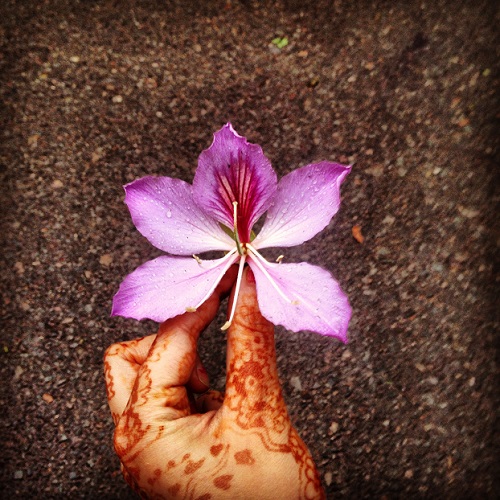

Another tree outside my apartment has sprouted fat, flamboyant orange and red flowers; I see crows snacking upon its buds in the mornings. These trees are the tallest and most majestic of them all; they also happened to be the first to begin blooming. In fact, I first saw their flowers fallen on the green grass, rather than on the branches. Afterward, the earth below those trees would become so densely carpeted with the blood-red flowers that it was almost as if a flower massacre had taken place.
Pittsburgh
I have to admit that I only became so interested in the business of blooming trees after I moved to Pittsburgh from Oman two winters ago. There’s something about being transplanted in a new country which compels you to be minutely aware of both its cultural and physical ecosystems: in case of the latter, its landscape, flora and fauna, and the visible, tangible transition of seasons. As I began to adapt to my new home, the trees outside my apartment balcony were my personal markers of the changing seasons; I first saw them winter-bare and snow-adorned before budding and eventually bearing leaves, flower, and fruit.
The other day, a Pittsburgh friend wrote to me, mentioning it was a lovely spring morning. I could easily conjure up the scene: the air’s promising, scented warmth, the tulips poking their heads through the soil, unmelting snowflakes of cherry blossom limning branches — and a magnolia-filled tree blooming in a churchyard. Before coming to the States, I had rarely seen magnolias; I made it a point to find out their name upon discovering this beautiful bloom. I wanted to populate the landscape I now called home with familiar faces, rather than faceless ones — and that included the foliage which grew and bloomed around me.
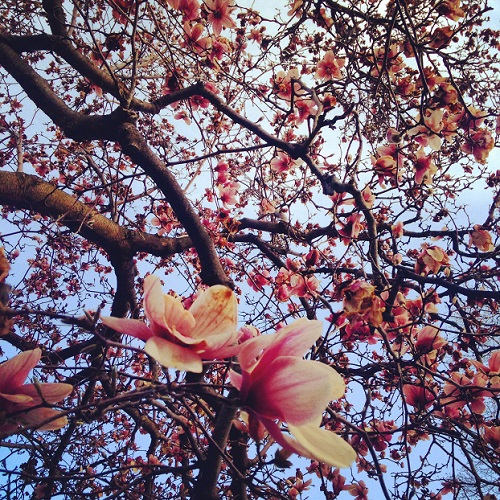
Boston
Watching the pink-lilac flower tree, I find myself thinking of the magnolias I glimpsed in Boston one spring afternoon last year.
I was eager to visit the city where so many beginnings and histories nested, in the country to which I would shortly be bidding adieu. I took the T to downtown one afternoon. In addition to experiencing the city’s elegant, history-drenched prettiness, I also yearned to see the sea, which I terribly missed in Pittsburgh after years of having lived in a sea-country, Oman.
I examined a map-imprinted signboard on the top of Beacon Hill and figured out the direction I would need to walk in order to meet the sea. However, although proud of my map sense, that day I failed to realize that I was heading away from the sea and towards the river. I was completely unaware walking past the stately, beautifully proportioned homes, richly anticipating the sea with each step.
After a while, I paused and gazed into the distance; the street appeared seemingly endless while the sea was nowhere in sight. I asked a passerby for directions.
“You are by the river,” he said kindly. “You are a long way from the sea.”
Lost & Found
I eventually found myself on the river bank, unable to summon up the energy to walk all the way back to the sea. I sat on a stone bench beneath a kind weeping tree and watched the sunbeams dance on the river surface. I took out a book of Marquez short stories that I had brought along with me; I stopped reading after only a few paragraphs and examined the stone-colored waters lapping the bank’s edges.
I was lost.
Yet, I knew it was much more than just losing my physical bearings; I felt a strong sense of displacement, as if I had fallen off a grid and did not know how to put myself back in or — where. I began to wonder if the feeling had to do with the truth that I had been playing dodge-ball with all this time: I would eventually find myself in yet another new country, a country which was officially my home but felt nothing like it.
I had endlessly discussed the transition with my husband, family, friends…I had even written about it, thinking words would be the best ships with which to navigate the sea of confusion and fear churning inside my head. This afternoon, though, as I watched the river slowly inch its way towards the sea, it was as if I clearly saw the move and its solid implications for the first time, rather than the abstractions I had been drowning in all this time.
I started walking back to the T — and it was then I encountered the avenue of magnolia trees in full, thick, unbearably beautiful bloom. It was as if I had stumbled upon a river of magnolia blossom: creamy pink, pale yellow, almost white, almost red. Petals constantly drizzled down upon the brick ground. They were entirely another entity altogether up on the trees; here, scattered, broken, they formed the hieroglyphics of an arcane nature language. I did not attempt to translate. I simply soaked in their beauty, consoled in a way that only nature was capable of doing.
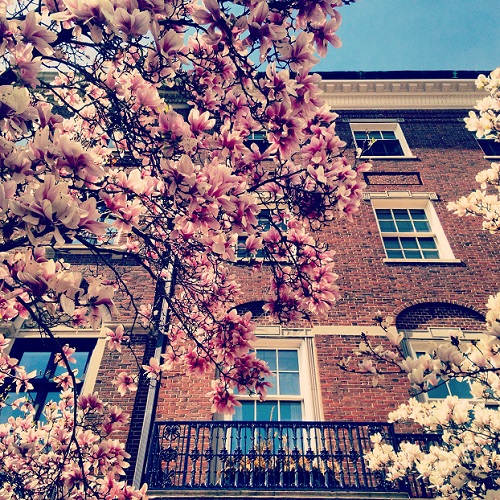
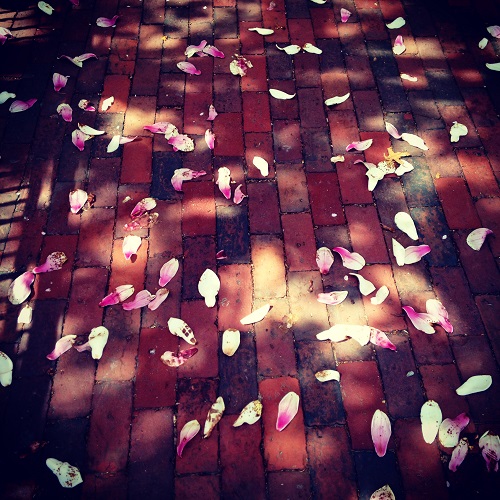
When I stood up, a fat butter-yellow petal detached itself it from a branch, whirling around in sunshine before resting on my shoulder. I opened the Marquez and placed the petal upon a bed of words. Many days later, when I opened the book, the petal was tea-brown — but in my eyes, it remained freshly yellow, a postcard from a day when flowers had gifted me with respite and hope amidst a sea of lost-ness.
Delhi
I have been living in Delhi for almost five months now. I am only just beginning to understand its languages; some days, I speak it somewhat fluently, even enjoying doing so. Some days, it metamorphoses into Greek, and I long for the comfort of familiar tongues. I wake up feeling homesick, not knowing if it is the seas of Oman that I yearn for or Pittsburgh’s summer-green woods. However, once again, as in America, I find myself watching the trees outside my apartment.
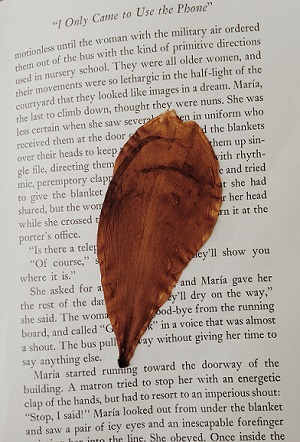
I learn that the fat red flowers belong to the silk cotton tree and the pink-lilac one is kachnar, a type of an orchid. I become familiar with their blooms, watching them fall in the air before eventually gracing the ground with their presence.
No matter where I journey, despite the multiple lands I call home in my lifetime and all the different languages and landscapes I must learn to speak and inhabit — nature and its quiet rhythms will always be teacher, guide, and friend.
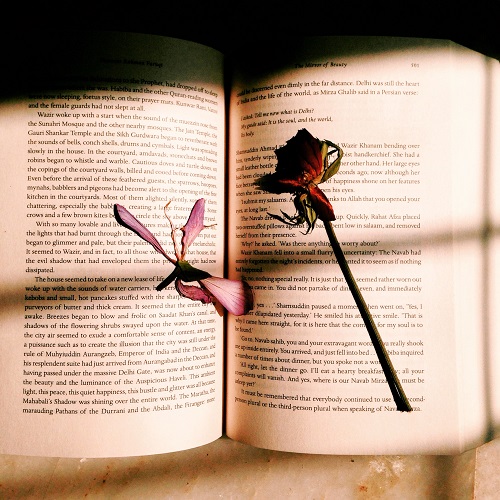
The fallen flower that I find goes inside a book too — and it will also become a memory of my new home, just like the magnolia petal from Boston represented a home from my yesterday.
We carry the chapters of homes and the passages in between as flower memories inside the books of our lives.
* * *
Photos and text by Priyanka Sacheti, an independent cultural writer living in Delhi. Her work has been featured in Gulf News, Khaleejesque, and Brownbook. When she’s not busy working on a collection of short stories or Instagramming, she blogs at I Am Just a Visual Person and Photo Kahanis. She tweets at @priyankasacheti.












